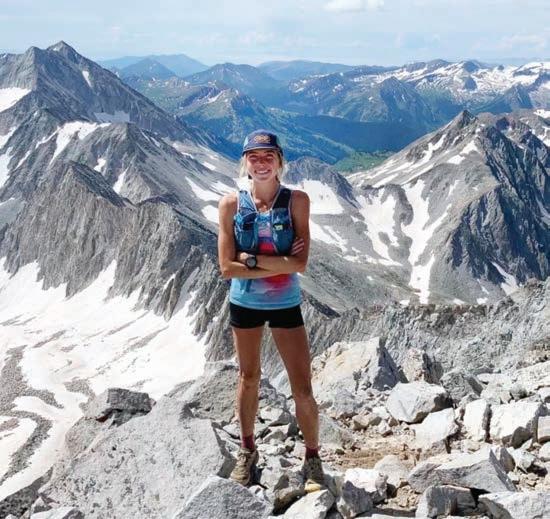
3 minute read
Athlete sets a self-supported mountain summiting record
BY CODY JONES SUMMIT DAILY NEWS
Erin Ton has long been a trailblazer in the world of mountain trail running. From trekking up rocky, mountain slopes in high heels, to climbing the equivalent of Mount Everest by lapping Boulder’s Mount Sanitas 23 times, Ton has not only pushed her body’s limits throughout the years, but has continued to fulll her love for climbing mountains in Colorado’s High Country
Born and raised on the Front Range, Ton developed a love for the outdoors at an early age. However, it wasn’t until she was home from college in summer 2018 that Ton was able to check hiking a 14er o her “true Colorado native” bucket list. “I hiked Mount Elbert with my sister and my dad,” Ton said. “At the time I thought it was the hardest thing I had ever done, but a couple days later we went back and did Grays and Torreys. I was just hooked. I caught the bug and just kept chipping away at them.”
While Ton was summiting 14er after 14er, she began to notice that she was getting up the peaks with a decent amount of speed compared to her friends, family and other hikers. Eventually this led Ton to break into trail running and truly start chasing after feats in the mountain endurance community.
After numerous outdoor adventures into the thin mountain air, Ton decided to set her eyes on a new and daunting athletic feat: the fastest known women’s self-supported Colorado summer 14ers time.
Consisting of 57 of Colorado’s 58 14ers — all but Culebra, which requires a climbing permit — the daring feat requires a large amount of preplanning, endurance, tness and physical and mental strength. On top of the route already being lled with physical challenges, no woman before Ton has ever attempted to complete the route completely self-supported, meaning Ton had to drive from trailhead to trailhead, carry her own food and did not have a crew helping her out.
With no real roadmap for how to achieve the women’s self-supported record, Ton said she looked towards the men’s self-supported summer 14ers record (14 days, 17 hours) and the women’s supported summer 14ers record (14 days, 14 hours) for guidance as she was planning out her attempt.

“It really is a logistical puzzle, which I personally enjoy,” Ton said. “A lot of it was actually molded o of supported e orts in the past, with the only di erence being that everything had to be designed as a loop connecting multiple peaks and starting and ending at the same trailhead or it had to be an out and back. I couldn’t start on one end of a mountain range and end on the other side.”
Besides planning the route and logistics of the trip. Ton also spent several weeks making sure her body was in the best shape possible heading into the record attempt.
“ ere were a lot of big vert weeks,” Ton said. “For the entire month leading up to the start of the record I was putting up 100 mile weeks with 40,000 feet of elevation gain. A lot of that is not redlining or sprinting, but it’s just building an e cient aerobic base and building those strong power hiking legs. You don’t necessarily need to be the fastest on each of these peaks individually to complete the record, you just need to be good at going, going and going.” was the one of 57 as she record she set roughout the journey, she was challenged by many things, but the weather started to play a signi cant role when Ton was in the process of summiting ve peaks in the Crestone Peak area of the Sangre de Cristo Range.
Ton o cially began her record attempt on July 16, quickly bagging Windom, Sunlight, North Eolus and Eolus peaks before moving onto the Wilson Peak group in southwest Colorado the following day.
From the start of the attempt, Ton was constantly on the move, either climbing or descending a grouping of peaks, shoveling calories into her mouth to stay properly fueled, driving to the next trailhead or snagging a few minutes of sleep.

Ton successfully reached the top of Humboldt, Kit Carson, Challenger and Crestone peaks in sunny conditions when she received a text from Chris Tomer, her weather forecaster, that weather was quickly approaching the area.
“ e clouds came rolling in fast,” Ton said. “Cracking thunder, lightning, rain which eventually turned to hail. Fortunately, I was able to nd a little rock cave shelter to take shelter in for about an hour.”
Eventually the storm clouds dissipated, allowing Ton to climb for a short period before another powerful thunderstorm crashed over the peaks. A couple hundred feet below the summit of Crestone Needle, Ton once again was forced to take shelter and wait out another storm.
With Ton’s phone dead, her Garmin inReach running out of power and in light clothes, she started to worry if she was going to be able to make it o the Crestone traverse before night fell over the area.
“I was stuck in a tricky situation,” Ton said. “I wasn’t prepared to be up there overnight if it took that long for the storm to pass.”
She debated sending out a search and rescue message out on her Garmin inReach before it died, but knew that may be overkill if she ended up getting up Crestone Needle and back down without a problem.
Eventually, Ton was able to summit Crestone Needle and make her way down, but the experience alone in the Crestones shook Ton, mak-



